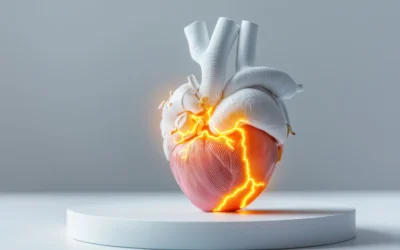Coronary Artery Spasm (CAS) refers to a temporary, sudden narrowing (spasm) of one of the coronary arteries. This narrowing restricts blood flow to the heart muscle, potentially leading to symptoms like chest pain (angina) and increasing the risk of other cardiac complications.
Overview
The coronary arteries supply blood to the heart muscle. A spasm in any of these arteries can temporarily deprive a section of the heart muscle of its blood supply, leading to various symptoms and potential complications. It’s crucial to recognize and manage CAS to maintain optimal heart health.
Symptoms
The primary symptom of CAS is angina. However, the manifestation of this angina might differ from typical angina caused by atherosclerosis:
- Chest Pain: Often severe, can radiate to the arms, neck, jaw, shoulder, or back.
- Timing: Unlike typical angina that often occurs with exertion, CAS-related pain can arise at rest, especially early in the morning.
- Duration: Pain from a spasm might last longer than typical angina, sometimes up to 30 minutes.
- Response to Medications: CAS-related angina usually responds quickly to nitroglycerin.
Causes
The exact cause of CAS is unclear, but several factors might trigger a spasm:
- Endothelial Dysfunction: Damage to the inner layer of the artery can increase susceptibility.
- Stimulants: Drugs like cocaine and certain medications might induce a spasm.
- Magnesium Deficiency: Low levels of magnesium can be a factor.
Risk Factors
Several factors can increase the risk of experiencing a coronary artery spasm:
- Tobacco Use: Smoking or using other forms of tobacco.
- High Cholesterol: Elevated cholesterol levels can damage the endothelium.
- Stress: Extreme emotional stress can be a trigger.
- Stimulant Use: Some medications, illegal drugs, or excessive alcohol.
- Underlying Conditions: Conditions like Raynaud’s disease or migraines might increase the risk.
Avoidance and Prevention
To reduce the risk of CAS:
- Avoid Tobacco: Completely abstain from smoking and other tobacco forms.
- Limit Alcohol: Consume in moderation.
- Manage Stress: Utilize techniques like meditation, deep breathing exercises, or yoga.
- Review Medications: Discuss potential triggering medications with your doctor.
- Maintain a Balanced Diet: Ensure adequate magnesium intake.
When to See the Doctor
Promptly seek medical attention if:
- Experiencing Unexplained Chest Pain: Especially if it’s sharp, severe, or different from previous patterns.
- Persistent Symptoms: If chest pain or discomfort persists beyond a few minutes.
- History of Heart Conditions: Those with known heart disease should be especially vigilant.
Additional Helpful Information
- Diagnostics: Besides routine cardiac evaluations, specialized tests like coronary angiography with provocative testing can identify CAS.
- Treatment: Calcium channel blockers and nitrates are primary treatments. Lifestyle changes also play a vital role.
- Prognosis: CAS can often be managed effectively with medications and lifestyle changes. However, severe cases can lead to heart attack or fatal arrhythmias.
- Research: Ongoing research aims to understand the deeper mechanisms of CAS better and identify potential new treatments.
Pathophysiology
While the precise mechanism causing CAS remains elusive, several processes are believed to play a role:
- Endothelial Dysfunction: This refers to impairment of endothelium-dependent vasodilation, caused by an imbalance between the secretion of vasodilators and vasoconstrictors. The dysfunction may lead to an exaggerated vasoconstrictor response.
- Hyperreactivity of the Vascular Smooth Muscle: The smooth muscle in the arterial wall may respond more forcefully than usual to stimuli that cause contraction, leading to spasms.
- Autonomic Nervous System Imbalance: An imbalance between the sympathetic and parasympathetic systems can influence the frequency and severity of spasms. The sympathetic system, responsible for the “fight or flight” response, can cause constriction of blood vessels.
The Role of Inflammation
Recent studies suggest a connection between CAS and inflammation. Patients with CAS have shown elevated levels of inflammatory markers. Chronic inflammation may damage the endothelial cells lining the coronary arteries, making them more susceptible to spasms.
Complications of CAS
While angina is the most common manifestation, other serious complications can arise:
- Myocardial Infarction (Heart Attack): Severe or prolonged spasms can cause damage to the heart muscle, leading to a heart attack.
- Arrhythmias: The lack of oxygen due to the spasm can disturb the heart’s normal rhythm, potentially leading to life-threatening conditions like ventricular fibrillation.
Genetic Predisposition
There’s evidence to suggest that certain individuals may be genetically predisposed to CAS. Specific genetic markers and mutations could make an individual more susceptible to the condition.
Environmental Triggers
Apart from the aforementioned drug and stimulant use, environmental factors like exposure to cold can also precipitate an episode of CAS. Cold weather can cause vasoconstriction, which might provoke a spasm in predisposed individuals.
Diagnosis Challenges
Diagnosing CAS can be challenging as spasms are often transient. Standard tests like angiography may not always detect CAS, especially if the patient is not undergoing a spasm during the test. Provocative testing, where certain drugs are administered to induce a spasm under controlled conditions, can be beneficial.
CAS and Exercise
While exertion commonly triggers angina in atherosclerotic heart disease, CAS-related angina can sometimes occur at rest. However, this doesn’t mean exercise is harmful for CAS patients. In fact, under medical guidance, regular cardiovascular exercise can promote heart health and reduce CAS episodes.
Emotional and Mental Health
It’s crucial to understand the profound impact CAS can have on an individual’s mental well-being. The unpredictability of episodes can cause anxiety or depression. Patients might benefit from counseling or joining support groups to share experiences and coping strategies.
In conclusion, Coronary Artery Spasm is a multifaceted condition with myriad factors influencing its onset and progression. A holistic approach, encompassing medical treatment, lifestyle changes, emotional support, and regular monitoring, can help manage this condition effectively. Understanding Coronary Artery Spasm is essential for those at risk and the general population. Recognizing symptoms and seeking timely medical care can prevent complications and enhance quality of life. Knowledge, lifestyle modifications, and appropriate medical interventions are key.









